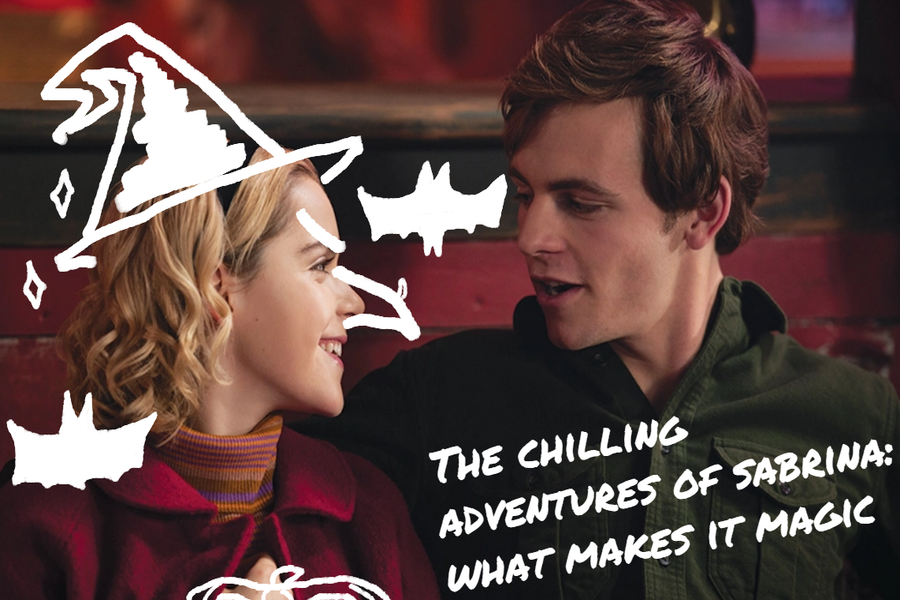The Chilling Adventures of Sabrina: What makes it magic?
graphic by Spencer Derrenberger
Netflix’s Sabrina exceeds expectations.
November 8, 2018
On October 26, Netflix dropped its newest, spookiest show, The Chilling Adventures of Sabrina. I had planned to review it, so I sat down with a pen and pad of paper, ready to tear it apart.
Sometime during Episode 5, I forgot to take notes.
The show’s creator, Roberto Aguirre-Sacasa, works as the series developer for Riverdale, a show popular among teens that started its third season on October 10. I watched season one and got halfway through season two before getting bored. With the dull plot of Aguirre-Sacasa’s other work, I didn’t expect much better from The Chilling Adventures of Sabrina.
But the show managed to surprise me. As a darker take on the cult classic Sabrina the Teenage Witch, it mixes the charm of its predecessor with an edgier, more modern twist. The characters were believable, and when it comes to modern fantasy, believable characters can be difficult to sell.
Viewers are drawn into Sabrina’s world; the costuming and aesthetics make the town of Greendale feel like something out of the past. It capitalizes on the resurgence of 90s nostalgia that other shows like Stranger Things have employed. While Sabrina is said to be in the same universe as Riverdale, and thus takes place in the modern day, it cultivates a feeling of a world out of time.
Unlike the original show, viewers become involved with Sabrina and the whole cast. Characters who were once just there to shove Sabrina’s story forward take on a life of their own. Sabrina’s aunts, Hilda and Zelda, have a complicated relationship. Hilda resents Zelda for controlling her life, and, although Zelda acts like she detests her younger sister, it’s revealed in Episode 4 that Zelda’s greatest fear is losing her.
The worst of my preconceptions vanished once Susie Putnam (Lachlan Watson) was introduced. Susie, one of Sabrina’s friends, is a non-binary character (played by a non-binary actor) who struggles with their gender identity throughout the show. They face bullying at school from the football team, and their fight for acceptance is Sabrina’s driving force when she fights for change within Greendale.
As a non-binary person, I’m immediately biased, but it was so amazing to see a character like Susie on television because there is little to no representation for us in media. It probably endeared me to Sabrina Spellman and the show in its entirety.
Aguirre-Sacasa capitalizes on that by revamping Sabrina as a local activist. She creates a club at her school for the purpose of protecting women from discrimination. She rallies behind her friend, Rosalind Walker, to stop the book-banning in her school. Within the witch community, or coven, in Greendale, she rebels against outdated laws and practices. The whole plot is based around Sabrina’s rebellious spirit when she refuses to sign over her name to Satan.
While I have issues with the portrayal of witches in this show, I admit that the characters are extremely well-written. However, I was continuously thrown off by the overall concept that “all witches are worshippers of Satan.” Witchcraft is still something that’s practiced today, so portraying all of them as devil-worshipers is incorrect, especially when some episodes revolve around the coven’s tradition of killing and eating one of its members.
What bothered me most was the attitude of the witches portrayed in the show. There’s this idea that witches are made by bloodline, and a group known as “The Weird Sisters” bullies Sabrina for being half-human, half-witch.
The show portrays the Greendale witch community as one full of discrimination. For example, the coven’s High Priest is obsessed with male-dominance; Sabrina’s aunt Zelda kidnaps his first born daughter in fear of what he’ll do to her because of his determination to have a male heir. A witch Sabrina meets in the woods is considered an outcast because she fled her coven after her High Priest tried to rape her at 14. The Weird Sisters are attacked for being orphans.
The conflict between Sabrina and the High Priest becomes highly stereotyped because of this. He’s one of the villains of the show, so it makes sense that he would be unlikable, but he lacks the level of complexity present in the other characters. The Weird Sisters may be Sabrina’s bullies, but they still have struggles and fears that the audience sees and relates to. In comparison, the High Priest is a weaker antagonist.
The cliche that is the High Priest is disappointing because the rest of the cast is so strong. For example, Aunt Zelda is committed to maintaining tradition, but we get to see her vulnerabilities. We see her fears of rejection and losing the people she cares about. She’s cruel to her sister, but she recognizes this and is at a loss on how to fix their relationship. Villains are made stronger when the audience can understand their motivations and sympathize with them. The show accomplishes this with most of its characters, especially when the show makes Sabrina the story’s villain; while she has good intentions, her actions hurt people sometimes. Seeing her failures is what attracts the audience to her.
Putting aside the issues about witches and media’s relationship, The Chilling Adventures of Sabrina is a good show, and it’s made one by the actors. They took these characters and not only brought them to life, but also made them a part of our lives. The actors made the audience care about the characters, which in turn made us more invested in the show. It is that skill that makes the show magic.




